Water, water…all around…water is water,right?
Well of course it is…but not quite…
The water from your tap is not the same as the water from a river, stream or lake and is obviously very different from the saltwater in the ocean.
The water in different rivers and lakes is not quite the same either nor is the ocean entirely uniform across the world.
Water varies greatly in different places depending on its mineral content, salinity, temperature and PH (acidity) levels. Tap water is treated to make it safe for us to drink but is it safe for our aquarium inhabitants?…
Over millennia, the fish, creatures, plants and corals that live underwater have adapted to quite specific water parameters and if we are going to look after them successfully then we must try to reproduce those conditions as closely as possible.
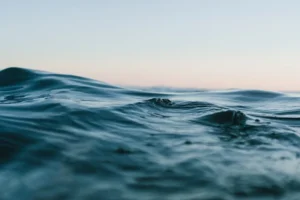
You wouldn’t put a goldfish in a saltwater tank would you?…or a clownfish in a pond…that’s obvious!
Likewise, coldwater fish such as goldfish prefer water temperature in the range of 60 – 70 degrees, tropical fish (fresh or saltwater) prefer water temperature in the range of 75 – 80 degrees and therefore you’ll need a good heater.
What is less obvious is that some tropical fish, creatures, plants and corals have also adapted to different water parameters and we must try to match those as closely as we can.
Table of Contents
Tap Water
The water from your tap has been treated with varying concentrations of fluorides and chloramines to make it safe for us to drink. It also contains high numbers of dissolved solids, salts, phosphates, nitrates, and microplastics.
The PH (acidity) level will also vary greatly depending on where you live. Hard or soft water, anyone?
I’m not going to go to great lengths about PH or water hardness here. (You can find out more about those if you want by following those links).
Just be aware that the water, straight out of your tap, is NOT suitable for keeping tropical fish.
Even if you use a de-chlorinator to remove the chloramines it will still contain varying degrees of dissolved solids, metals, phosphates, nitrates and other pollution which can be harmful to your tank inhabitants or lead to various problems down the line.
What is really need is pure water…just H2O…
What is RO Water
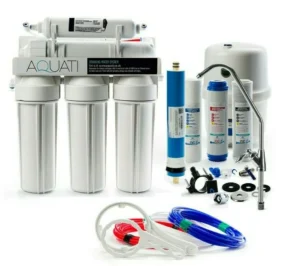
RO stands for Reverse Osmosis. This is a process to demineralize water by pushing it under pressure through semi-permeable membranes.
The membranes only allow water molecules through and prevent larger molecules, like minerals and other chemicals, from passing through.
This will remove 95% to 98% of the impurities. Good, but not quite good enough. We want 100% removal.
That’s where RODI water comes in. 99 times out of 100 when people in the fish-keeping community refer to RO water they actually mean RODI water.
RODI stands for Reverse Osmosis Deionized Water.
RODI water has passed through an additional step of deionization where the filtration system exchanges positive and negative molecules making the water 100% pure.
Why Use RO Water In Your Aquarium
Using RO Water in your aquarium is the best way to look after your tank inhabitants. It gives you a starting base of zero to control your water parameters.
Marine Aquariums
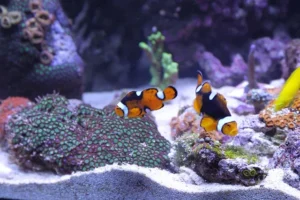
The high levels of dissolved solids, phosphates and nitrates in tap water can cause huge problems in a marine aquarium.
Trace amounts of copper and other metals can be toxic to your coral, fish and invertebrates. TDS (total dissolved salts) can be very high in tap water, much higher than found anywhere in the ocean.
Also, high levels of phosphates and nitrates found in tap water can lead to algae problems and coral loss.
Using RO water means you aren’t introducing more harmful elements every time you do a water change.
Freshwater Aquariums
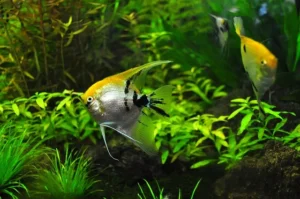
Likewise in a freshwater aquarium, the high levels of dissolved solids, phosphates and nitrates in tap water will lead to similar algae problems.
Some fish, such as Discus, and some plants require low PH, soft water. While other fish, like African cichlids, should have a high PH of approximately 8.2 to 8.4.
Using RO water in your aquarium means you are in control, you can manage the water parameters and keep them where you want them.
Using RO Water in an Aquarium
However, it is very important to note that you can’t just use RO water as it is.
It is simply too pure, being stripped of any minerals which may help to support your aquarium inhabitants.
So, we need to add back those minerals that our aquariums do need…
Marine Aquariums
In a marine aquarium, this is done by the obvious process of adding salt using a good marine salt mix.
There are many different saltwater mixes available and you should do some research on what is available. We recommend the one below:-
 | Aquarium Systems Reef Crystals 20kg | Check pricing on eBay >> *Free UK Delivery |
Freshwater
In a freshwater tank, you can do exactly the same. Yes. Add salt. But not marine tank salt. Freshwater tank salt.
Again, there are many different types available and you should do some research on which one will be the best for your freshwater tank inhabitants. We recommend the one below:-
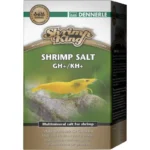 | Shrimp King Shrimp Mineral GH/KH | Check pricing on eBay >> *Free UK Delivery |
Where Can I Get RO Water?
Most local fish stores will sell RODI water. Prices in the UK should vary between £2 – 5 for 20 – 25 litres.
Take care, though, as not all fish stores keep their RO Water Filter Systems properly maintained. Some get complacent and don’t replace the filters often enough leading to unacceptable levels of TDS.
How will you know? Simple. Test the RO water.
You can test the PH. It should be between 6.0 – 6.5. All good test kits have a PH test.
You can also easily check the General Hardness (GH) level. It should be zero.
We use the test kit below for this:-
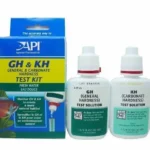 | API GH/KH Test Kit | Check pricing on eBay >> *Free UK Delivery |
Even at £2 – 5 for 20 – 25 litres, buying RODI water for your aquarium can get quite costly over time, particularly for larger tanks. So, why not make your own?…
RO Water Filter System
To make your own RODI water you will need a RODI water filter system. They come with 3 – 5 stages of filtration but for full RODI water you need all 5 stages.
5 Stage RO Water Filter System
The 5 stages are:-
- Sediment prefilter: Removes dirt, sand, silt and other sediments up to 5 Micron
- Carbon prefilter: An activated carbon pre-filter absorbs chlorine, other chemicals and multiparticle organic substances that cause water to taste and smell unpleasantly.
- 2nd carbon prefilter: Another activated carbon pre-filter that removes 98% to 99% of free chlorine, chlorinated solvents, aromatic hydrocarbons, pesticides of chlorogenic origin and polyaromatic compounds.
- RO membrane: The reverse osmosis membrane filters remove harmful organic and non-organic compounds, heavy metals and some bacteria and viruses.
- Polishing filter: deionizing cartridge filled with high quality DI resin for complete demineralization of water.
Best RO Water Filter System
We recommend the one below:-
 | Aquati 5 Stage RO Water Filter System | Check pricing on eBay >> *Free UK Delivery |
Using RO Water In Your Aquarium FAQs
Can I use RO water in my aquarium? – You can, and we recommend it, BUT you can’t just use pure RO water as it has been stripped of any minerals that may help to support your aquarium inhabitants.
You must, therefore, first remineralize it by adding back those useful minerals and chemical elements.
How do you Remineralize reverse osmosis water for a fish tank? – As RO water has been stripped of any minerals and chemical elements used by your aquarium inhabitants you must first remineralize it.
In a marine tank, this is done by using a good salt mix, in a freshwater tank, this is done by using freshwater tank salt.
Will adding RO water lower pH? – RO water will have a neutral PH of 7 so it should not impact PH directly. However, the PH will change as you remineralize it and this should be done to match the existing PH of your tank water.
